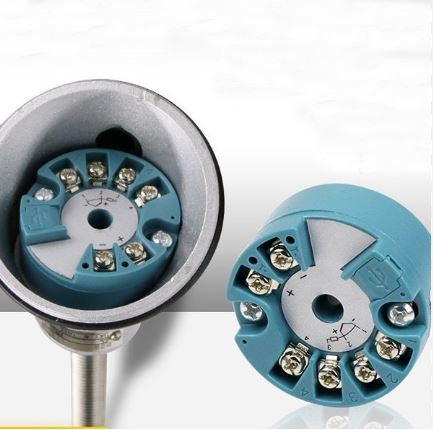Table of Contents
In industrial and process control applications, accurate and reliable temperature measurement is essential for monitoring and controlling various processes. Head mount temperature transmitters are devices that convert the temperature readings from a temperature sensor into a standardized output signal, typically a 4-20mA current loop. This article ” What is a Head Mount Temperature Transmitter?” will explain what head mounted temperature transmitters are and explore their advantages in industrial applications.

Understanding Head Mounted Temperature Transmitters
A head mounted temperature transmitter is a compact electronic device that is installed directly onto the head of a temperature sensor, such as a resistance temperature detector (RTD) or a thermocouple. It converts the sensor’s analog temperature signal into a current signal, which can be easily transmitted over long distances without signal degradation. The transmitter provides accurate temperature measurement and is compatible with various types of temperature sensors.





Advantages of Head Mounted Temperature Transmitters
Head mounted temperature transmitters offer several advantages in industrial applications:
1. Easy Installation
Head mounted temperature transmitters are designed for simple and convenient installation. They can be easily mounted directly onto the head of the temperature sensor, eliminating the need for additional wiring or separate enclosures. This streamlined installation process saves time and reduces wiring complexity.
2. Space Efficiency
The compact size of head mount temperature transmitters makes them ideal for applications where space is limited. Their design allows for installation in tight spaces or in environments where traditional transmitters or enclosures may not fit. This space efficiency is particularly beneficial in crowded control cabinets or equipment with limited mounting options.
3. Versatility
Head mounted temperature transmitters are compatible with various temperature sensors, including RTDs and thermocouples. This versatility allows them to be used in a wide range of temperature measurement applications, accommodating different temperature ranges and environmental conditions. They can be easily integrated into existing temperature measurement systems, providing flexibility and compatibility.
4. Signal Conditioning
Head mounted temperature transmitters offer signal conditioning capabilities. They convert the raw analog temperature signal from the sensor into a standardized current signal, typically a 4-20mA current loop. This standardized output simplifies signal transmission over long distances without signal degradation, ensuring accurate and reliable temperature measurement at the receiving end.
5. Remote Monitoring and Control
With the standardized current output signal, head mount temperature transmitters enable remote monitoring and control of temperature measurements. The current signal can be easily interfaced with control systems, distributed control systems (DCS), programmable logic controllers (PLC), or other monitoring devices. This allows for centralized monitoring, data logging, and control of temperature measurements from a remote location, enhancing process efficiency and automation.
Conclusion
Head mounted temperature transmitters provide a range of advantages in industrial temperature measurement applications. Their easy installation, space efficiency, versatility, signal conditioning capabilities, and compatibility with remote monitoring systems make them a preferred choice for accurate and reliable temperature measurement. By utilizing head mount temperature transmitters, industries can enhance their process control, improve efficiency, and ensure optimal temperature monitoring in various applications.
Frequently Asked Questions (FAQs)
FAQ 1: Can head mount temperature transmitters be used in hazardous environments?
Yes, certain head mount temperature transmitters are designed for use in hazardous environments and carry appropriate certifications, such as ATEX or IECEx, indicating their suitability for such conditions.
FAQ 2: Do head mount temperature transmitters require external power?
Yes, head mount temperature transmitters typically require an external power supply, commonly 24V DC, to operate and provide the necessary current loop output.
FAQ 3: Are head mount temperature transmitters compatible with different temperature sensors?
Yes, head mount temperature transmitters are designed to be compatible with various temperature sensors, including RTDs and thermocouples. They can accommodate different sensor types and temperature ranges.
FAQ 4: How accurate are head mount temperature transmitters?
The accuracy of head mount temperature transmitters can vary depending on the model and manufacturer. They are available with different accuracy classes, such as 0.1%, 0.2%, or 0.5% of the temperature span, indicating the level of accuracy they provide.
FAQ 5: Can head mount temperature transmitters be easily configured and calibrated?
Yes, head mount temperature transmitters usually feature user-friendly configuration options. They can be easily configured using push buttons, DIP switches, or software tools provided by the manufacturer. Calibration procedures are also available to ensure accurate temperature measurement.
Hope you liked this article on “ What is a Head Mounted Temperature Transmitter ”. You are invited for any kind of suggestion or feedback in the comment box. You can also mail us your suggestions or feedback directly at theinstrumentguru@gmail.com. To read more such articles related to Technology, Electronics and Instrumentation. You can also download our Android App. Click here to download the mobile app.
Read Also
- What is Pump Cavitation? How to Avoid Cavitation?
- What are Distributed Temperature Sensors (DTS) in Power Lines ?
- Response Time Test of RTD and Thermocouple
- Automated Block Valve (ABV)
- Temperature Transmitter Preventive Maintenance
- SIS Emergency Block Valves (EBV)
- What are the Installation Precautions of Thermocouple and RTD ?
- Control Valve Positioner
- Troubleshooting Common Control Valve Problems
- What is thermal mass flow meter?
- Control Valve more Articles